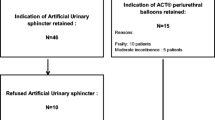Abstract
Purpose
Artificial urinary sphincters (AUS) remain the gold standard to treat male stress urinary incontinence. AUS implantation can be performed through a penoscrotal or perineal incision depending on surgeon preference.
Methods
The present study compares initial AUS implantation through two surgical approaches focusing on outcomes of continence and revision. All AUS implanted at an academic medical center between 2000 and 2018 were retrospectively reviewed.
Results
A total of 225 AUS implantations were identified, of which, 114 patients who underwent virgin AUS placement were included in the study with a mean follow-up of 28.5 months. A total of 68 patients (59.6%) had AUS placement through penoscrotal incision; while, 46 (40.4%) had a perineal incision. While operative time was significantly shorter for penoscrotal placement (98.6 min vs. 136.3 min, p = 0.001), there were no significant differences in continence rates between either surgical approach with 76.5% socially continent defined as using zero to less than 1 pad per day (safety pad). The overall rate of device erosion or infection was not significantly different between groups. However, the rate of revision or replacement was significantly higher in the perineal group (26.1% v. 8.8%; p = 0.01). On multivariate analysis, the penoscrotal incision predicted a lower rate of device revision (p = 0.01).
Conclusions
The penoscrotal approach of AUS placement is associated with shorter operative time. While we observed a lower revision rate compared to the perineal approach, there were equivalent continence outcomes.
Similar content being viewed by others
References
Viers BR, Linder BJ, Rivera ME et al (2016) The impact of diabetes mellitus and obesity on artificial urinary sphincter outcomes in men. Urology 98:176–182
Linder BJ, Rivera ME, Ziegelmann MJ, Elliott DS (2015) Long-term outcomes following artificial urinary sphincter placement: an analysis of 1082 cases at Mayo Clinic. Urology 86(3):602–607
Lai HH, Hsu EI, Teh BS, Butler EB, Boone TB (2007) 13 years of experience with artificial urinary sphincter implantation at Baylor College of Medicine. J Urol 177(3):1021–1025
Kim SP, Sarmast Z, Daignault S, Faerber GJ, McGuire EJ, Latini JM (2008) Long-term durability and functional outcomes among patients with artificial urinary sphincters: a 10-year retrospective review from the University of Michigan. J Urol 179(5):1912–1916
Sandhu JS, Breyer B, Comiter C et al (2019) Incontinence after prostate treatment: AUA/SUFU Guideline. J Urol 202(2):369–378
Burkhard FC, Bosch JLHR, Cruz F, et al. European Association of Urology Guidelines. 2020 Edition. 2020;presented at the EAU Annual Congress Amsterdam 2020. https://uroweb.org/guideline/urinary-incontinence/. Accessed 17 Apr 2020
AMS 800 Urinary Control System For Male Patients: Operating Room Manual (2017), pp 15–21
Wilson SK, Delk JR, Henry GD, Siegel AL (2003) New surgical technique for sphincter urinary control system using upper transverse scrotal incision. J Urol 169(1):261–264
Wilson SK, Aliotta PJ, Salem EA, Mulcahy JJ (2010) New enhancements of the scrotal one-incision technique for placement of artificial urinary sphincter allow proximal cuff placement. J Sex Med 7(10):3510–3515
Mykoniatis I, Albersen M, Andrianne R et al (2020) Synchronous surgery for the combined treatment of post-radical prostatectomy erectile dysfunction and stress urinary incontinence: a lucrative evolution or an unnecessary complexity? Int J Impot Res. https://doi.org/10.1038/s41443-020-0253-5
Henry GD, Graham SM, Cornell RJ et al (2009) A multicenter study on the perineal versus penoscrotal approach for implantation of an artificial urinary sphincter: cuff size and control of male stress urinary incontinence. J Urol 182(5):2404–2409
Henry GD, Graham SM, Cleves MA, Simmons CJ, Flynn B (2008) Perineal approach for artificial urinary sphincter implantation appears to control male stress incontinence better than the transscrotal approach. J Urol 179(4):1475–1479
Shen Y-C, Chiang P-H (2012) Is the penoscrotal approach inferior to the perineal approach for artificial sphincter implantation in male urinary incontinence? A preliminary experience. Int J Urol 19(8):786–789
de Cógáin MR, Elliott DS (2013) The impact of an antibiotic coating on the artificial urinary sphincter infection rate. J Urol 190(1):113–117
Hüsch T, Kretschmer A, Thomsen F et al (2017) Antibiotic coating of the artificial urinary sphincter (AMS 800): is it worthwhile? Urology 103:179–184
Author information
Authors and Affiliations
Contributions
CJS: Protocol/project development, data collection or management, data analysis, manuscript writing/editing. AS: Protocol/project development, data collection or management, manuscript writing/editing. ON: Data collection or management, data analysis, manuscript writing/editing. EY: Data collection or management. MKK: Protocol/project development, data collection or management. SK: Protocol/project development, data collection or management. MDH: Protocol/project development, data collection or management, data analysis, manuscript writing/editing.
Corresponding author
Ethics declarations
Conflict of interest
The authors declare that they have no conflict of interest.
Ethical approval
This retrospective chart review study involving human participants was in accordance with the ethical standards of the institutional and national research committee. The institution research board of Northwestern University approved this study.
Informed consent
Informed consent was obtained from all individual participants included in the study.
Additional information
Publisher's Note
Springer Nature remains neutral with regard to jurisdictional claims in published maps and institutional affiliations.
Rights and permissions
About this article
Cite this article
Staniorski, C.J., Singal, A., Nettey, O. et al. Revisiting the penoscrotal approach to artificial urinary sphincter surgery: how does it compare to a perineal incision for initial implantation?. World J Urol 39, 871–876 (2021). https://doi.org/10.1007/s00345-020-03244-6
Received:
Accepted:
Published:
Issue Date:
DOI: https://doi.org/10.1007/s00345-020-03244-6



